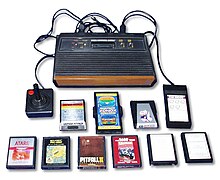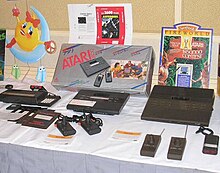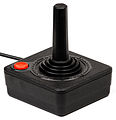Atari 2600
| Atari 2600 | ||||
|---|---|---|---|---|
|
|
||||
| Manufacturer | Atari | |||
| Type | stationary game console | |||
| generation | second generation of consoles | |||
| publication |
|
|||
| Main processor | MOS Technologies 6507 | |||
| Graphics processor | Atari TIA | |||
| Storage media |
Module cassettes (with the Starpath Supercharger) |
|||
| Controller | Digital joysticks Trackballs |
|||
| Online service | none | |||
| Units sold | > 30 million | |||
| Most successful game | Pac-Man (approx. 7 million units sold) | |||
| predecessor | Atari Home Pong | |||
| successor | Atari 5200 | |||
| info | Until 1982 as Atari Video Computer System (VCS), marketed in Japan as Atari 2800 | |||
The Atari Video Computer System ( Atari VCS ) is a stationary game console of the second generation of consoles , which was first presented to the public in 1977 and was first released on September 11, 1977 in the United States. To make it easier to differentiate between Atari's successor consoles, the Darth Vader version was released in November 1982 and was renamed the Atari Video Computer System 2600 ( Atari VCS 2600 or Atari 2600 ). From 1986 a visually slimmer and more cost-effective variant was offered under the name Atari 2600 Junior and produced well into the 1990s.
With the Atari VCS, the concept of separating hardware and software, originally developed by Magnavox and Fairchild , finally achieved its commercial breakthrough. In contrast to the console and slot machine games of the time, which were implemented purely by circuitry (hard-wired), there was a basic device with a microprocessor . The software (almost exclusively video games ) was put in the form of a memory module (called “game cassette” in Germany) in a closed plastic housing in a slot between the controls on the top of the housing. The ease of use of the technology and, last but not least, a lavish range of inexpensive games contributed to the widespread use of the console, the name of which was partly synonymous with video game consoles until the so-called video game crash in 1983.
With over 30 million copies sold worldwide, the Atari VCS is by far the best-selling game console of its time. The most successful Atari 2600 game was Pac-Man with around 7 million units sold.
history
The Atari Video Computer System was introduced in 1977. Sales were sluggish until 1979. Atari therefore acquired a number of slot machine and film licenses, including Space Invaders , Pac-Man and ET From Christmas 1979, the Atari 2600 was the best seller in the Christmas season, although the console was already technically outdated at that time; in particular the extremely small RAM of only 128 bytes compared to other consoles at the time was out of date in 1979 because main memory was much cheaper than two years earlier. A noteworthy expansion of the memory was achieved with the separately available Starpath Supercharger module , which, however, was not economically viable and was therefore only rarely used.
A variant of the Atari 2600 was released in Japan in 1982 under the name Atari 2800 , better known in the US as Sears Video Arcade II .
In between there were always prototypes. The all-in-one system CX-2000 started in 1981, in the same year a similar system with the number 2500. The Atari 2200 (code name "Bonnie") from 1983 is the precursor to the 2600 junior model. Atari's wireless 2700 was already ready for the market, the advertising was running when the combination controller (joystick and paddle in one) failed in quality control. They had a range of about 300 meters and could have disrupted other 2700 consoles in the neighborhood. Garage doors could also have been opened with it - the technology largely corresponds to that of the hand-held radio transmitters. The console would have had to be redeveloped, but that would have been too expensive, especially since the market was on the verge of a crash anyway . The last prototype was the CX-3000 Graduate Computer in 1983 , which would have turned the 2600 into a home computer with the help of a membrane keyboard and a BASIC module. However, there was a possibility that it could have competed with the in-house Atari XL computer ; the project was thus stopped.
From 1983 sales stagnated and collapsed completely in 1984, which was not least due to the fact that more powerful, yet inexpensive home computers , such as. B. the Atari 800 or the Commodore 64 were available. The Atari 2600 also had strong competition from the significantly more powerful competing consoles Intellivision from 1979 and ColecoVision from 1982.
The collapse of the video game market in 1983 and 1984 almost drove Atari to bankruptcy, as the management's expectations of the outdated console were too high and there were no significant developments. Another reason was the overproduction of game modules and, compared to the competition, the poor quality of the games, which was reflected, among other things, in the poor utilization of the already weak hardware. In 1984 Atari, Inc. was split up into Atari Corporation (game consoles & home computers) and Atari Games (arcade machines).
When the game consoles became popular again from around 1985 with the Nintendo Entertainment System , the Atari Corporation brought a lower-cost and physically scaled-down, but otherwise fully compatible version of the Atari 2600 onto the market in 1986 under the name Atari 2600 Junior . The device was officially referred to as the Atari 2600. The design is reminiscent of that of the later Atari 7800. Shortly before that, the largely downward-compatible Atari 7800 appeared (which had already been sold for a month in 1984, but was postponed due to the poor market situation). In Germany the 2600 Junior was sold until 1991, in some Asian countries for a few years longer.
The Atari Flashback Portable was released in 2016 as a handheld version of the Atari 2600 . In November 2018, the Atari Retro Handheld with 50 built-in games and a wooden look was released a year late .
Technical specifications
- CPU : MOS Technologies 6507 , a 6502 variant with an address space reduced from 64 kB to 8 kB and a clock frequency of approx. 1.19 MHz .
- Video processor: Atari TIA , also known as Stella after the original code name of the project (the name Stella was derived from the brand of a bicycle owned by an Atari engineer). 128 different colors ( NTSC ), 104 different colors ( PAL ) or eight different colors ( SECAM ), each from 128 theoretical color numbers. No video RAM ; the CPU has to write every single line of the screen in real time into a line buffer, synchronized with the raster beam of the television. The program has to adhere to a tight time frame so that the video output does not collapse. This made the system very difficult to program, but extremely flexible for the circumstances at the time. NTSC programs have to be rewritten for PAL and SECAM and vice versa.
- Audio processor: Atari TIA, two voices, various waveforms. Output in mono through the TV speaker.
- RAM : 128 bytes ; some game modules from 1983 onwards contained an additional 128 or more bytes of RAM in the module.
- Data carrier: ROM modules. Early modules were only 2 kB in size, originally a maximum of 4 kB was intended. From 1981, however, many modules contained additional hardware to make larger memories addressable by means of bank switching . Up to 16 kB was common, a few multi-game modules contained up to 64 kB.
- Switch on the device: On / Off, black and white / color, level of difficulty (left player), level of difficulty (right player), game selection, start game. The difficulty level switches were used in later variants, such as B. the Darth Vader model, scaled down and relocated to the back of the console. Not every game used all the switches; all switches except on / off could be assigned any meaning by the game, as they are evaluated by the respective program. With Moonpatrool , for example, you could switch the music on and off with the difficulty level switch, as many players found this annoying.
- Interfaces: power supply (3.5 mm jack socket , 9 volts direct current, tip + / shaft -), module port (24-pin circuit board socket in 2.54 mm grid), two connections for input devices such as joysticks and paddles (9- pin D-Sub connector without screws; connector shape and assignment has become the de facto industrial standard in the home computer sector), RF antenna output 75 Ohm, VHF channel selectable between 2 and 3 using a slide switch.
Games and other applications


In total, more than 1200 games were published for the Atari 2600, although not all of them were officially licensed by Atari. Many games came from Atari itself, and Activision became a leading third-party provider after 1979 .
Some of the most famous games for the Atari 2600 (selection):
1977:
The following nine games were presented together with the VCS:
- Air-Sea Battle (CX2602)
- Basic Math
- Blackjack (Atari 2600)
- Combat (Atari 2600)
- Indy 500 (Atari 2600) (CX2611)
- Star Ship (Atari 2600)
- Street Racer (Atari 2600)
- Surround (Atari 2600) (CX2641)
- Video Olympics (several variants of the game of pong )
1978:
- A Game of Concentration (CX2642)
- Breakout (CX2622)
- Sky Diver
1979:
- Adventure
- Outlaw (CX2605)
- Atari 2600 Basic Programming
- Video Chess (CX2645)
1980:
- 3-D Tic-Tac-Toe (CX2618)
- Circus Atari
- Checkers (CX2636)
- Dodge 'em (CX2637)
- Night Driver (CX2633)
- Skiing
- Space Invaders (CX2632)
- Video Pinball (CX2648)
1981:
- Asteroids (CX2649)
- Defender (CX2609)
- Freeway
- Haunted House (CX2654)
- Ice hockey
- Kaboom!
- Gorf
- Missile Command (CX2638)
- Pac-Man (CX2646)
- Stampede
- Super Breakout (CX2608)
- Tennis (CX2680)
- Yars' Revenge (CX2655)
1982:
- Astroblast
- Atlantis
- Berzerk (CX2650)
- Burgertime
- Carnival
- Centipede (CX2676)
- Chopper Command
- Custer's Revenge
- Donkey Kong
- ET the Extra-Terrestrial (computer game) (CX2674)
- Journey Escape
- Mouse trap
- Ms. Pac-Man (CX2675)
- Phoenix (CX2673)
- Picnic
- Pitfall!
- Raft rider
- Raiders of the Lost Ark (CX2659)
- River raid
- Shootin 'Gallery
- Star Raiders (CX2660)
- Star Wars: The Empire Strikes Back (first Star Wars video game )
- Venture
1983:
- Alpha Beam (Atari Sesame Street Library, CX26103)
- Asterix
- Big Bird's Egg Catch (Atari Sesame Street Library, CX26104)
- Cakewalk
- Cookie Monster Munch (Atari Sesame Street Library, CX26102)
- Dig Dug (CX2677)
- Donkey Kong Jr.
- Enduro
- Frogger
- Galaxian (CX2684)
- Jungle Hunt (CX2688)
- Kangaroo (CX2689)
- Mario bros.
- Moon Patrol (CX2692)
- The Music Machine
- Joust (CX2691)
- Pole Position (CX2681)
- Rabbit transit
- RealSports Soccer (CX2667)
- Snoopy and the Red Baron (CX26111)
- Q * bert
- Bobby goes home
- Decathlon
1984:
1987:
Not yet classified:
- Ice hockey fever
- reactor
- Swordquest Earthworld (CX2656)
- Swordquest Fireworld (CX2657)
- Demons to Diamonds (CX2615)
- Math Gran Prix (CX2658)
- Sorcerer's Apprentice (CX26109)
- Donald Duck's Speedboat (CX26108)
- Dumbo's Flying Circus (CX26115)
- Vanguard (CX2669)
- Real Sports Football (CX2668)
- Real Sports Baseball (CX2640)
- Real Sports Volleyball (CX2666)
- Spacewar! (CX2604)
- Golf (CX2634)
- Battlezone (CX2681)
- Warlords (CX2610)
Homebrew
After the Atari 2600 has not been manufactured for many years, new games are still being created in the 2010s that are programmed by fans of the console themselves. These are so-called homebrew games (English for homemade). Most of them are written directly in the machine language of the 6502 processor. The programming of a game for the Atari 2600 is considered to be very demanding due to the small memory space.
The developed games can either be played via an emulator, or the development is copied onto the chip of a cartridge and played directly via the console.
Movies
In 1999, the two-part VHS documentary "Stella at 20" was released, which brought the makers, managers and programmers of the Atari 2600 console together for its 20th anniversary. Both parts are about 90 minutes long.
emulation
The best known emulator for the VCS is probably Stella , who emulates the system almost perfectly and is available for many systems (such as Windows , Nintendo DS , etc.). Even within a game, Minecraft , an emulator for the Atari 2600 was created.
See also
- Bit-90 , a home computer from 1984 that was compatible with the Atari 2600
- Atari VCS (2020) , a game console from Atari SA , based on the Atari 2600
literature
- Ben Coulson: The Midnight Tiger: Complete Guide to Atari 2600 Video Games. Upfront Publishing, Leicestershire 2003, ISBN 1-84426-265-0 .
Web links
- Atari-Age - Extensive site with forums, game tests, collecting tips, price index, package scans and emulators (English)
- Atari 2600 on atarimuseum.de
- Atari Museum Pictures of some model variants of the Atari 2600 (German)
- atari-spielanleitungen.de Game instructions for download and articles about Atari and video games
- neXGam.de game tests and other specials around the Atari 2600 (German)
- Jakks Pacific - manufacturer of modern Atari 2600 clones (English)
- Article at The Dot Eaters - A very detailed representation of the Atari 2600 history
- German article on the introduction of the Atari 2600 in Germany
- Category "Atari 2600" at MobyGames (many screenshots and descriptions)
- Documentation for programming the Stella processor (PDF, English) (754 kB)
Individual evidence
- ↑ Top 10 best-selling Atari 2600 games. ign.com, August 26, 2008, accessed January 4, 2017 .
- ↑ Atari 2600 Video Computer System / 2800 - atarimuseum.de. Retrieved September 20, 2019 .
- ^ Atari VCS - Computing History. Retrieved September 20, 2019 .
- ^ DS Cohen A. gaming writer, developer, teacher, Video Game Historian, Gaming Industry Professional: All About the Atari 2600: the Longest Running Video Gaming Console. Retrieved September 20, 2019 .
- ↑ A Brief History of Game Console Warfare | BusinessWeek. May 9, 2007, accessed May 10, 2019 .
- ↑ Jeremy Reimer: EA's Madden 2007 sells briskly, but are games gaining on movies? September 1, 2006, Retrieved February 18, 2019 (American English).
- ↑ gambitmag
- ↑ Stella at 20
- ↑ Stella: "A Multi-Platform Atari 2600 VCS Emulator". In: stella.sourceforge.net. Retrieved December 15, 2016 .
- ↑ Chris Kohler: Super Hacker builds Atari 2600 emulator ... In Minecraft ⁈ . In: WIRED . ( wired.com [accessed December 15, 2016]).











